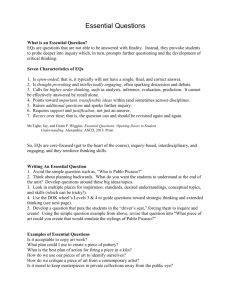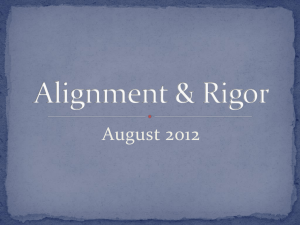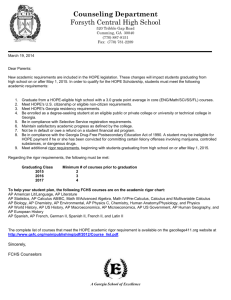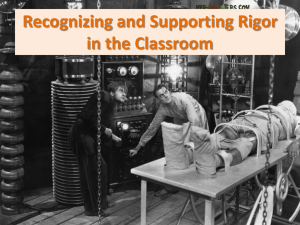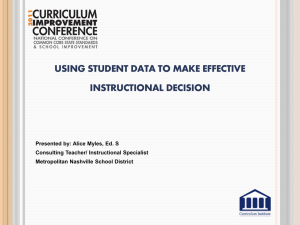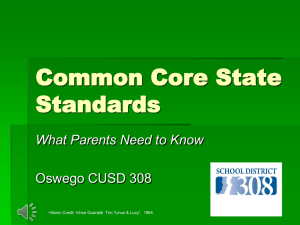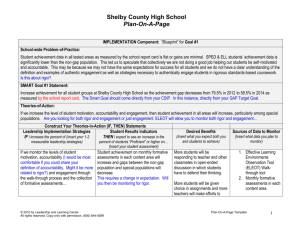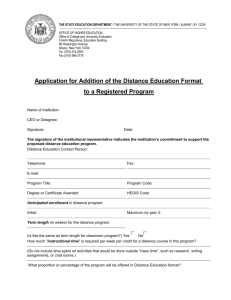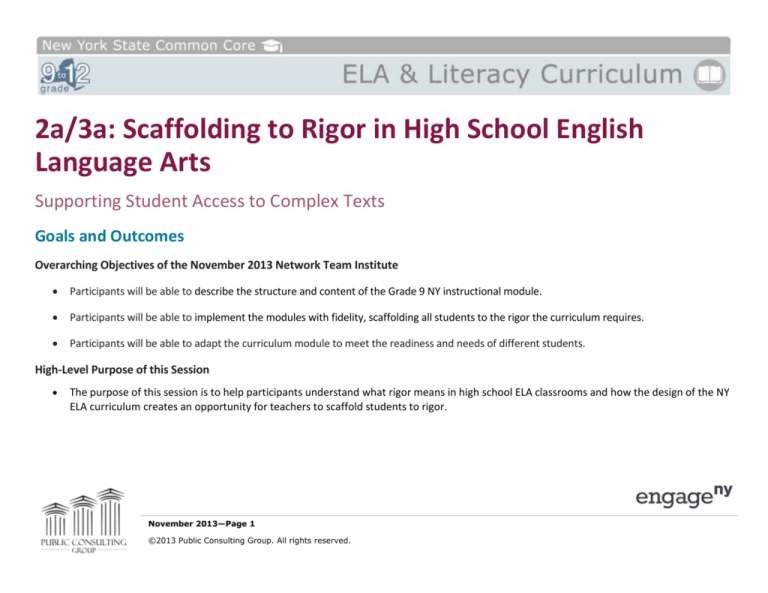
2a/3a: Scaffolding to Rigor in High School English
Language Arts
Supporting Student Access to Complex Texts
Goals and Outcomes
Overarching Objectives of the November 2013 Network Team Institute
Participants will be able to describe the structure and content of the Grade 9 NY instructional module.
Participants will be able to implement the modules with fidelity, scaffolding all students to the rigor the curriculum requires.
Participants will be able to adapt the curriculum module to meet the readiness and needs of different students.
High-Level Purpose of this Session
The purpose of this session is to help participants understand what rigor means in high school ELA classrooms and how the design of the NY
ELA curriculum creates an opportunity for teachers to scaffold students to rigor.
November 2013—Page 1
©2013 Public Consulting Group. All rights reserved.
New York State Common Core
Session Outcomes
What do we want participants to be able to do as a result of this session?
●
Explain how the NY Grade 9 ELA Curriculum module helps teachers scaffold
students to rigor.
● Explore the concept of rigor in high school and ways rigor can be supported in the
classroom.
How will we know that they are able to do this?
Aligned survey question
Related Learning Experiences
1b: Supporting Curriculum Material Use
2b: Structures and Systems: Homework, Annotation, and Accountable Independent Reading
Key Points
Rigor must be a part of every classroom environment.
The CCSS Shifts require instructional rigor.
The 9th Grade ELA NY Curriculum design and delivery methods help students access complex texts while maintaining rigor.
Rigor is a shared responsibility of the curriculum and the instruction, but it ultimately “lives” in instruction. Although the 9th grade ELA
curriculum is designed with rigor in mind, what a teacher does to enhance, reinforce, adapt, and adopt makes the greatest difference.
November 2013—Page 2
©2013 Public Consulting Group. All rights reserved.
New York State Common Core
Session Overview
Section
Time
Overview
Prepared Resources
Facilitator Preparation
Introduction and
Welcome
5 min
Introduce the session.
Session PowerPoint
Read and download session
materials.
Understanding Rigor
Sampling the
Curriculum: Rigor in
the Text
Sampling the
Curriculum: Rigor in
the Instructional
Design
25 min
23 min
18 min
Participants will surface current
understandings about rigor, read 4
Myths about Rigor in the Classroom,
annotate the text, and discuss
implications for curriculum and
instruction.
Participants will read an excerpt
from “St. Lucy’s Home for Girls
Raised by Wolves” and discuss,
central understandings and the
complexity and rigor of the text.
Participants will analyze a sample of
the curricular materials, focusing on
how those materials support the
ideas about rigor explored in the
article.
November 2013—Page 3
©2013 Public Consulting Group. All rights reserved.
Session PowerPoint
What is Rigor handout
4 Myths About Rigor in the
Classroom article
Read and download session
materials.
Session PowerPoint
Read and download session
St. Lucy’s Home for Girls Raised
materials.
by Wolves text excerpt
Session PowerPoint
9.1.1 Unit Overview
9.1.1 Lesson 1
9.1.1 Lesson 16
Read and download session
materials.
New York State Common Core
Section
Scaffolding to Rigor:
Text-dependent
Questioning and the
9th Grade ELA NY
Curriculum
Time
Overview
13 min
Participants will apply what they
know about close reading by
examining a difficult section of a
lesson and brainstorming additional
scaffolding questions to support
diverse learners.
Reflection and Closing 6 min
Participants will reflect on their
learning.
90 mins total for this session
November 2013—Page 4
©2013 Public Consulting Group. All rights reserved.
Prepared Resources
Facilitator Preparation
Session PowerPoint
St. Lucy’s Home for Girls Raised
by Wolves text excerpt
Read and download session
9.1.1 Unit Overview
materials.
9.1.1 Lesson 1
9.1.1 Lesson 16
Session PowerPoint
Read and download session
materials.
New York State Common Core
Session Roadmap
Introduction and Welcome
In this section, you will introduce the session and its purpose.
Slide
Time
1
0 min
Picture
Materials used include: Session PowerPoint
Script/Activity directions
Welcome participants to the session.
November 2013—Page 5
©2013 Public Consulting Group. All rights reserved.
New York State Common Core
Slide
Time
2
5 min
Picture
Script/Activity directions
Review the purpose of this session. Talking points include:
This session is about rigor in high school and what it takes to create
rigor.
This curriculum is designed to create the conditions for rigor in the
classroom, but it does not constitute rigor itself. Curriculum is not a
substitute for careful instructional planning that creates rigorous
experiences for students.
Because rigor is not absolute, it is necessary to consider the context
in which rigor lives. This means that, as teachers, we consider the
curriculum, our instruction, our assessments, and our students in
order to ensure rigor.
In this session, we will consider the features of this curriculum that
create opportunities for rigor and how teachers can use and build
upon those opportunities to meet their students’ unique learning
needs.
Total
time:
5 mins
November 2013—Page 6
©2013 Public Consulting Group. All rights reserved.
New York State Common Core
Understanding Rigor
In this section, participants will surface current understandings about
rigor, read 4 Myths about Rigor in the Classroom, annotate the text,
and discuss the implications for curriculum and instruction.
Slide
3
Materials used include: Session PowerPoint, “What is Rigor” handout,
4 Myths about Rigor in the Classroom article
Time Picture
Script/Activity Directions
0 min
Transition into the “Understanding Rigor” section of the session.
November 2013—Page 7
©2013 Public Consulting Group. All rights reserved.
New York State Common Core
Slide
4
Time Picture
10
min
Script/Activity Directions
Ask participants to read the three quotes on the What is Rigor? handout and
annotate the text, looking for ideas that resonate with you.
Lead a brief whole group discussion of their observations, surfacing current
perspectives about rigor.
5
15
min
Ask participants to read the 4 Myths About Rigor in the Classroom article. Ask
them to annotate the text, focusing on the following:
Concepts that connect or resonate with you.
Words that would be a part of your definition of rigor.
Concepts or ideas that might surprise others. It may be helpful to ask
participants to consider how thinking in terms of others may help striving
readers.
Ask participants to share their annotations and discuss the following questions
in groups of two to four (depending on room setup):
What is rigor?
November 2013—Page 8
©2013 Public Consulting Group. All rights reserved.
New York State Common Core
Slide
Time Picture
Script/Activity Directions
Where does rigor “live?”
How can this information assist teachers in the classroom?
Lead a whole group discussion of observations, making sure to address the
following key points:
Rigor does not live in a text. Rigor is created in the instruction—the
implementation—of curriculum.
We can assign complex texts, but HOW we treat them can be rigorous—
good questions, engaging and rigorous activities, discussions, writing
assignments, challenging projects and assessments.
Implementation can also lack rigor—low level questions, giving away
answers, over-scaffolding (providing more scaffolding than students
actually need) or scaffolding in the wrong ways.
Total
time:
25
mins
November 2013—Page 9
©2013 Public Consulting Group. All rights reserved.
New York State Common Core
Sampling the Curriculum: Rigor in the Text
In this section, participants will read an excerpt from St. Lucy’s Home for Materials used include: Session PowerPoint, St. Lucy’s Home for Girls
Girls Raised by Wolves and discuss their central understandings and the Raised by Wolves text excerpt
complexity and rigor of the text.
Slide
6
Time Picture
Script/Activity Directions
0 min
Transition in to the “Sampling the Curriculum” section of the session.
November 2013—Page 10
©2013 Public Consulting Group. All rights reserved.
New York State Common Core
Slide
7
Time Picture
23
min
Script/Activity Directions
Participants should have read this text for homework. Provide eight minutes
for participants to reread (or read) pages. 237-239 of St. Lucy’s Home for Girls
Raised by Wolves by Karen Russell.
Ask participants to consider the following as they read:
What makes this text complex and potentially rigorous for 9th graders?
What particular challenges might your students have with this text?
What are some of the key ideas and understandings in this section of
the text?
Provide ten minutes for participants to discuss their responses.
Lead a brief (five minute) whole group discussion of their observations, making
sure to address the following key points:
Total
time:
23
mins
November 2013—Page 11
©2013 Public Consulting Group. All rights reserved.
This text has rich vocabulary, a straight forward, yet complex narrative
structure, complex characters, and multiple themes.
The vocabulary is particularly challenging and beautiful; and the
inferences students need to make to determine the key ideas in the
text can be challenging.
New York State Common Core
Sampling the Curriculum: Rigor in the Instructional Design
In this section, participants analyze a sample of the curricular materials,
focusing on how those materials support the ideas about rigor explored
in the 4 Myths about Rigor in the Classroom article.
Slide
8
Time Picture
18
min
Materials used include: Session PowerPoint, 9.1.1 Unit Overview, 9.1.1
Lesson 1, 9.1.1 Lesson 16.
Script/Activity Directions
Instruct participants to take about eight minutes and read the Unit Overview
and Unit 9.1.1, Lesson 1. Encourage participants to look for evidence of the
article’s perspectives about rigor. Notice:
The amount and type of homework
Teacher and student actions
The types of questions and support for reading closely
The amount of text considered each day
Ask participants to spend ten minutes discussing their findings in pairs. Lead a
brief report out, guiding participants to make the following connections:
November 2013—Page 12
©2013 Public Consulting Group. All rights reserved.
The curriculum deals with small pieces of text each day, but goes into
them deeply.
Questions are scaffolded to build toward key understandings slowly.
Questions focus on vocabulary as well as key ideas and other textual
elements.
New York State Common Core
Slide
Time Picture
Script/Activity Directions
Total
time:
18
mins
November 2013—Page 13
©2013 Public Consulting Group. All rights reserved.
Homework is closely tied to the learning goals of the lessons and is
designed to engage students in a deeper consideration of the content.
Teacher actions are designed to create space for students to consider
text while holding them to a high standard for academic thinking.
New York State Common Core
Scaffolding to Rigor: Text-dependent Questioning and the 9th Grade ELA NY Curriculum
In this section, participants will apply what they know about close
reading by examining a difficult section of a lesson and brainstorming
additional scaffolding questions to support diverse learners.
Slide
9
Materials used include: Session PowerPoint, St. Lucy’s Home for Girls
Raised by Wolves text excerpt, 9.1.1 Unit Overview, 9.1.1 Lesson 1, 4,
and 16.
Time Picture
Script/Activity Directions
8 min
Direct participants to look more closely at the sequence of questions on pages 1315 of Lesson 1. As they do, they should think about: What is happening in this
section of the lesson? Describe the types of scaffolding you observe.
November 2013—Page 14
©2013 Public Consulting Group. All rights reserved.
New York State Common Core
Slide
10
Time Picture
Script/Activity Directions
2 min
Provide the following framing: How can questions provide scaffolding?
11
3 min
With participants, review the key points from earlier NTIs about adding additional
text-dependent scaffolding questions. Good questions:
Total
time:
Guide students toward important understandings without “giving them
the answers.”
Support students to unpack the language of the text and build vocabulary.
Model where to look for “important ideas”
13
mins
November 2013—Page 15
©2013 Public Consulting Group. All rights reserved.
Can be answered only with evidence from the text.
Can be literal (checking for understanding) but also involve analysis,
synthesis, and evaluation.
Focus on words, sentences, and paragraphs, as well as larger ideas,
themes, or events.
Focus on difficult portions of text in order to enhance reading proficiency
New York State Common Core
Discussion and Reflection
In this section, you will reflect on your learning and consider implication Materials used include: Session PowerPoint
for practice.
Slide
Time
12
6 mins
Picture
Script/Activity directions
Encourage participants to reflect on the concepts of adoption, adaption, and
support. Have participants discuss the following questions:
Total
time:
6 mins
November 2013—Page 16
©2013 Public Consulting Group. All rights reserved.
How can this curriculum help teachers create “an environment in which
each student is expected to learn at high levels, each student is
supported so he or she can learn at high levels, and each student
demonstrates learning at high levels”?
What do teachers need to do with this curriculum to create this? What
additional support might they need?
New York State Common Core
Turnkey Materials Provided
Session PowerPoint
Facilitator Guide
What is Rigor? handout
4 Myths about Rigor in the Classroom (available at http://static.pdesas.org/content/documents/M1-Slide_21_4_Myths_of_Rigor.pdf)
Curriculum Sampler:
o 9.1.1 Unit Overview
o 9.1.1 Lesson 1
o 9.1.1 Lesson 16
November 2013—Page 17
©2013 Public Consulting Group. All rights reserved.


